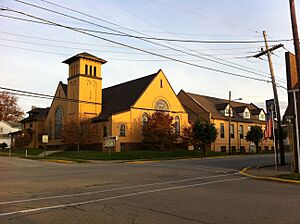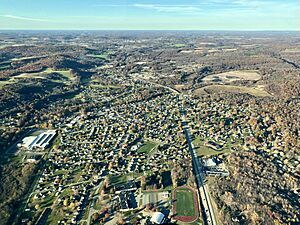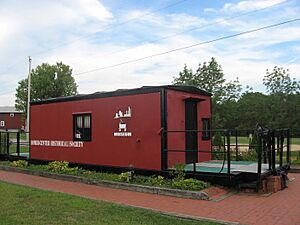Homer City, Pennsylvania facts for kids
Quick facts for kids
Homer City, Pennsylvania
|
|
|---|---|

Businesses on Main Street
|
|
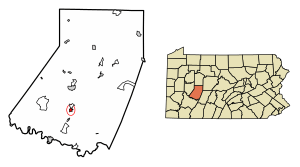
Location in Indiana County, Pennsylvania
|
|
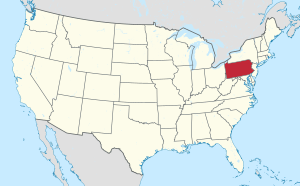
Location of Pennsylvania in the United States
|
|
| Country | United States |
| State | Pennsylvania |
| County | Indiana |
| Area | |
| • Total | 0.56 sq mi (1.45 km2) |
| • Land | 0.55 sq mi (1.43 km2) |
| • Water | 0.01 sq mi (0.02 km2) |
| Elevation | 1,375 ft (419 m) |
| Population
(2020)
|
|
| • Total | 1,730 |
| • Density | 3,134.06/sq mi (1,209.57/km2) |
| Time zone | UTC-5 (EST) |
| • Summer (DST) | UTC-4 (EDT) |
| ZIP code |
15748
|
| Area codes | 724, 878 |
| FIPS code | 42-35408 |
Homer City is a small town, called a borough, in Indiana County, Pennsylvania, United States. In 2020, about 1,746 people lived there. Homer City is part of the larger Indiana metro area. The town got its name from the famous Greek poet Homer. It was founded in 1854 by William Wilson and became an official borough on September 26, 1872.
Contents
A Look at Homer City's Past
The land where Homer City is today became open for settlement after two important agreements called the Treaties of Fort Stanwix in 1768 and 1784. Before this, the land was home to six Native American nations. In the 1700s, not many European settlers lived here, and meeting Native Americans was a common part of life. The area became safer after a battle in 1794.
In 1803, Indiana County was created from parts of other counties. Homer City was considered for the county's main town, but instead, the county seat went to what is now the Borough of Indiana. Center Township, the area around Homer City, was formed in 1807. It had many family farms and a growing number of mills and trading posts.
Early settlers in the Homer City area included Scots-Irish Presbyterian families. Later, Methodist families of English and Welsh descent became very important in the town's business and community life. William Wilson planned the village of Homer in 1854, naming it after the Greek poet. For a few years, its post office was called Phillips Mill, after an early settler. When the village became a borough in 1872, people started calling it Homer City.
With a post office and a stop on the Pennsylvania Railroad, Homer City grew like many small towns in the late 1800s and early 1900s. It offered shops, a bank, doctors, and schools. These services were for people living in the borough and those in the nearby rural Center Township. Center Township also saw the growth of "company towns" built by coal companies in the early 1900s. These towns were often named after the companies or their owners.
After World War II, people in Homer City and Center Township became more prosperous. Better roads and more cars led to new homes being built around Homer City and in the farmlands of Center Township. This trend continues today with new housing areas.
The Homer-Center School District covers both the Borough of Homer City and Center Township. Because of this, and because many people use "Homer City" for their mailing address, it can sometimes be confusing where the borough ends and the township begins. Even places outside the borough, like the Homer City Generating Station, use a Homer City address.
A storybook called The Roving Red Rangers was set in the Homer City area. It was written by Charles Asbury Robinson in 1902. Sometimes, people mistakenly thought this story was real history. This led to some wrong ideas about the area's past. For example, the name "Laura Lamar," from a character in the book, was chosen for the local school district in 1952.
Homer City Today
Homer City has many businesses that serve its residents. These include a bank, a grocery store, restaurants, hair salons, and doctors' offices. The community is kept safe by the Homer City Police and the Homer City Volunteer Fire Department. Some of the oldest buildings in Homer City are its churches, like Homer City United Methodist Church and Holy Protection Byzantine Catholic Church.
The Homer City Generating Station, which is a power plant located nearby in Center Township, has the tallest chimney in the United States. It's also the third tallest in the world!
The local radio station for the borough is 1160 WCCS, known as "The Voice of Indiana County".
Homer City became well-known in the early 1900s because of the Prairie State Incubator Company. Their products were shown at exhibitions across the country. After fires destroyed their factories twice, the company built a new "fire-proof" building. However, they stopped making products soon after. In 1920, the Syntron Company, which made industrial tools, moved into that same building. For many years, Syntron was the biggest employer in Homer City. It continued to operate until 2007. Another company, Non-Lethal Technologies, Inc., also has a Homer City address, even though its main location is near Aultman and Jacksonville.
Quick Facts About Homer City
- ZIP code: 15748
- Area Code: 724
- Local Phone Exchanges: 479, 915
Learning in Homer City
The borough is part of the Homer-Center School District. The schools are located just south of the borough line.
Famous People from Homer City
- Steve Demeter (born 1935) - A professional baseball player for the Detroit Tigers and Cleveland Indians in 1959 and 1960.
- Ralph McConnaughey (1889–1966) - A professional baseball player in 1914.
- Patricia (Hilliard) Robertson (1963–2001) - A NASA astronaut who joined in 1998.
- Dave Reed (born 1978) - A former Pennsylvania State Representative and Majority Leader.
- Ben McAdoo - A professional football coach and former Head Coach of the New York Giants.
Fun Things to Do and See
The Hoodlebug Trail
The Hoodlebug Trail is a path that goes through Homer City. It stretches north towards Indiana Borough and south towards Black Lick. This trail was once a railroad line. Now, it's a great place for walking, running, and biking. Indiana County Parks and Trails has added signs along the trail that tell you about historical and natural sights. The trail is named after the hoodlebug, which was a self-propelled train car. It carried passengers and mail from Indiana to Blairsville until 1940.
Floodway Park: A Place to Play
Floodway Park is a large park in Homer City. It has two softball fields, a covered picnic area, a walking trail, and restrooms. It's also a starting point for the Hoodlebug Trail. The park's name tells you about its history. It's located on a natural flood plain next to Yellow Creek. Before a big flood in 1977, this area was part of the main street with businesses and homes. The flood caused a lot of damage. After cleanup, the park was created in the early 1990s. This shows a new way to use land that can flood: create a park that can be used regularly but won't be ruined if flooding happens again.
Caboose-Museum Site: Explore Local History
The Caboose-Museum Site is run by the Homer-Center Historical Society. The main museum is inside an old Pennsylvania Railroad caboose (the last car on a train). It holds old items, documents, and research about the history of Homer City and Center Township. There's also a small building next to it for bigger displays. The museum is open on Saturdays and Sundays from Memorial Day to Labor Day, and by appointment. The Historical Society also works with the borough on the "Local Hero" Banner Program. This program honors local military members with banners displayed along Main Street.
The Hoodlebug SummerFest
The Hoodlebug Festival is a fun event held in early September. It has many games and activities for local residents. It was first called SummerFest and was held in July. The festival's name now comes from the old passenger train service, the "hoodlebug," and the Hoodlebug Trail.
Homer City Auctions
Every spring, Homer City hosts a large equipment sale. There are also weekly auctions for livestock (farm animals) and a fall sale for calves.
Where is Homer City?
Homer City is located at 40°32′23″N 79°09′33″W / 40.539672°N 79.159244°W. It is about 6 miles from Indiana, 30 miles from Greensburg, 25 miles from Johnstown, and 50 miles from Pittsburgh.
The United States Census Bureau says the borough covers about 0.6 square miles (1.6 square kilometers) of land.
Who Lives in Homer City?
| Historical population | |||
|---|---|---|---|
| Census | Pop. | %± | |
| 1880 | 381 | — | |
| 1890 | 505 | 32.5% | |
| 1900 | 570 | 12.9% | |
| 1910 | 985 | 72.8% | |
| 1920 | 1,802 | 82.9% | |
| 1930 | 2,004 | 11.2% | |
| 1940 | 2,078 | 3.7% | |
| 1950 | 2,372 | 14.1% | |
| 1960 | 2,471 | 4.2% | |
| 1970 | 2,465 | −0.2% | |
| 1980 | 2,248 | −8.8% | |
| 1990 | 1,809 | −19.5% | |
| 2000 | 1,844 | 1.9% | |
| 2010 | 1,707 | −7.4% | |
| 2020 | 1,746 | 2.3% | |
| 2021 (est.) | 1,738 | 1.8% | |
| Sources: | |||
In 2000, there were 1,844 people living in Homer City. Most residents were White (99.40%). About 22.1% of the population was under 18 years old. The average age was 42 years.
The median income for a household in the borough was about $30,815. This means half of the households earned more than this, and half earned less. About 10.8% of the population lived below the poverty line.
Many residents of Homer City have German (18%), Italian (17%), Irish (11%), and Polish (9%) ancestry.
How Homer City is Governed
Homer City is governed by a mayor and a seven-member council. The council meets on the first Tuesday of every month to discuss borough business.
- Mayor: Arlene Wanatosky
- Borough Council members: Matthew Black (President), Elizabeth Brown, Joseph Iezzi Sr., Jennifer Jaworski, Kenneth "Cal" Cecconi, Christine Worcester, and Richard Jones.
See also
 In Spanish: Homer City para niños
In Spanish: Homer City para niños


